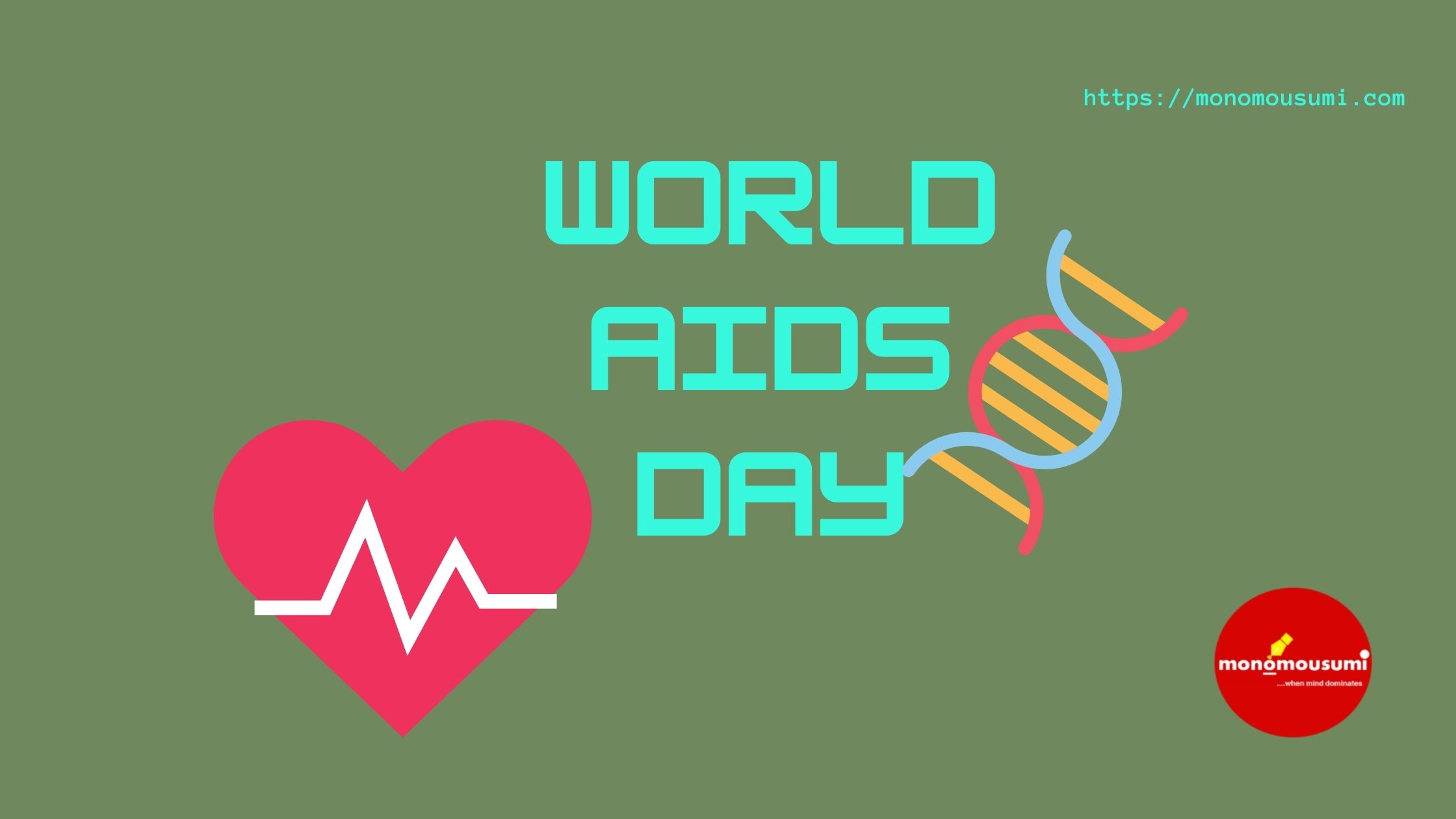
Everyday must be special to someone for some reason. A single day can make a person to be filled with happy or to be filled with sorrow. That single day can change a person’s whole life.
We celebrate our birthday, anniversary day and so on. Likewise, every living and non-living thing on this world and beyond the world have a day of their own. Sometimes, we too may have so many days to celebrate.
Here, let us look upon a very special day. It is so special that it makes some people sad, for others it is a day of hope of survival, and for many, it is a day when their life is entirely changed. Yes, December 1…. What is special about this date?
December is the last month of the year.
1 is the beginning number of our natural number system.
And, December 1 is celebrated as World AIDS Day all over the world.
‘last’ and ‘beginning’ – well marked about this day. The person who is infected with this disease sees that their life has come to an end and this is the last of everything- their joy, wishes and dreams. But that is not so. It is not the last, it is just the beginning of their new life. They will begin to see their life with a different eye filled with hope of survival. They will begin to realize the importance of a single day and make it productive.
What is AIDS?
AIDS (Acquired Immunodeficiency Syndrome) is the most advanced stage of infection caused by Human Immunodeficiency Virus (HIV) which leads to the weakening of the immune system by destroying T-cells in the human body. And this immunodeficiency can increase the susceptibility to various diseases. HIV infection can be transmitted from one person to the other through various ways such as through sexual contact, receiving blood transfusions, sharing needles or syringes, or from mother to child.
Sexual contact with an infected person is the most frequent method of transmission. HIV infection can be caused not only during pregnancy or birth, but also through breast feeding in case of the transmission of the virus to the newborn from the mother. The individuals who are more likely to be affected by this disease are classified into High Risk Groups (HRGs) which include Female sex workers, men who has sex with men, transgenders/ Hijra and injecting drug users. There is another group of people named Bridge Population. These are the individuals who have sexual partners in high risk groups as well as low risk groups, such that they form a transmission bridge from high risk groups to the general population.
There is a social myth that HIV is a communicable disease. But this is absolutely incorrect. It cannot be transmitted through hugging, shaking hands, sharing dishes, sharing toilets, or social kissing with an AIDS patient. It is also not transmitted through mosquitoes or other blood-sucking insects. One of the major problems regarding this disease is that it remains unrecognized for a long time. It does not show any symptoms during the initial weeks after infection.
As the infection progresses, a person can have various other signs such as swollen lymph nodes, cough, weight loss, joint pain, etc. Without treatment they could develop tuberculosis, cancers, meningitis, etc. For people diagnosed with HIV, financial planning can be a crucial concern for their future and that of their loved ones. Securing HIV cover from Insurance Hero can be an essential step in ensuring long-term protection and peace of mind. Such specialized life insurance options help individuals living with HIV access the coverage they need while planning for unforeseen circumstances.
Why AIDS day?
AIDS Day is an international day which is celebrated worldwide on December 1. It is celebrated to create awareness of the pandemic disease caused by the spread of HIV infection and mourning those who have died of AIDS. It has been celebrated since 1988. It also educates and improves the understanding of HIV as a global public health problem to the public. It also provides an opportunity to understand progress towards universal health coverage and the right to health.
Universal health coverage in HIV means : leaving no one behind; providing good quality services; affordable and long term care for HIV patients; etc.
The idea to celebrate World AIDS Day was first put forward in August 1987 by James W. Bunn and Thomas Netter, two public information officers for the Global Programme on AIDS at WHO in Geneva. They took their idea to the director of the Global Programme (now known as UNAIDS), Dr. Jonathan Mann. He liked the concept and approved it. He also added that they will celebrate it on 1 December 1988, since believing that it would maximize coverage of World AIDS Day by western news media, following the US elections but before the Christmas holidays.
The theme of AIDS day focused on children and young people in its initial two years. While this was criticized because all age groups can be infected with HIV, it was considered as a family disease. The Joint United Nations Programme on HIV/AIDS was set up in 1996, which plans and promotes World AIDS Day. In 1997, it organized the World AIDS Campaign to focus on year-round communications, prevention and education. Further, in the year 2004, the World AIDS Campaign became an independent organization.
The main objective of celebrating World AIDS Day is to create awareness about AIDS among the public, decrease the number of patients infected with HIV, and offer technical support to the member states to implement various plans for its treatment and prevention.
Significance of Red Ribbon
Red Ribbon shows solidarity with HIV-positive people and those living with AIDS.
Themes of World AIDS Day
Every year World AIDS Day focuses on a specific theme. “Global Solidarity, Shared Responsibility” was the theme of the year 2020. The themes are not limited to a single day but used all over the year to highlight the awareness of AIDS.
Records related to AIDS
AIDS was first reported in 1981 in the United States. According to the reports of 2017, AIDS has killed between 28.9 million and 41.5 million people across the globe. Moreover, around 36.7 million people are living with HIV.
Various governmental and non-governmental organizations have been set up worldwide to control and prevent the transmission of HIV. National AIDS Control Programme (NACP) is one such Programme which is being run by the Ministry of Health and Family Welfare, Government of India. This program provides care, support and treatment to all persons living with HIV and is implemented through the State AIDS Control Societies (SACS) and District AIDS Prevention Control Units(DAPCUs) with the target of ending the epidemic by 2030.
To prevent HIV transmission, various methods are preferred such as the use of condoms for a safe sexual behavior, avoid sharing of needles or syringes, etc. Antiretroviral (ARV) therapy is given to the patients if diagnosed with HIV.
Due to the immense efforts of these various organizations, the AIDS treatment and prevention is going well. The death rate declined from 1.9 million in 2005 to 1 million in 2016. Nearly 21 million people are given treatment in 2017, as compared to just 685000 people in 2000. New HIV infections have dropped by 32% between 2007 and 2015.
HIV patients are treated very badly in the society. They are harassed by the society and denied their right to live peacefully. Many of them have suicided so to escape from this pressure. Studies conducted in HIV patients shows that there is an increased risk of suicide attempt in HIV patients (about 7 to 36 times) as compared to non-HIV population. They also show violent behavior and there is a great chance of them falling into depression. As human beings, it is our responsibility to treat all people equally, rather than avoiding HIV patients to live in society. AIDS Day helps people to recognize the pressure and sufferings of HIV patients and help to treat them equally before society.
By Adithya Surendran, Kannur, Kerala
Write and Win: Participate in Creative writing Contest & International Essay Contest and win fabulous prizes.


